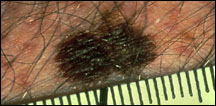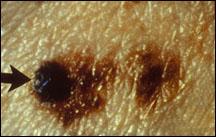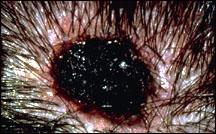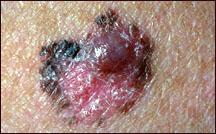Pictures of Ordinary Moles and Dysplastic Nevi
|
Ordinary Moles |
Dysplastic Nevi |
| Color |
Evenly tan or brown; all typical moles on one person tend to look similar. |
Mixture of tan, brown, and red/pink. A person’s moles often look quite different from one another. |
|
 |
 |
| Shape |
Round or oval, with a distinct edge that separates the mole from the rest of the skin. |
Have irregular, sometimes notched edges. May fade into the skin around it. The flat portion of the mole may be level with the skin. |
|
 |
 |
| Surface |
Begin as flat, smooth spots on skin (1a); may become raised (1b) and form a smooth bump (1c). |
May have a smooth, slightly scaly, or rough, irregular, “pebbly” appearance. |
|
 |
 |
| Size |
Usually less than 5 millimeters (about 1/4 inch) across (size of a pencil eraser). |
Often larger than 5 millimeters (about 1/4 inch) across and sometimes larger than 10 millimeters (about 1/2 inch). |
|
 |
 |
| Number |
Between 10 and 40 typical moles may be present on an adult’s body. |
May be present in large numbers (more than 100 on the same person). However, some people have only a few dysplastic nevi. |
|
 |
 |
| Location |
Usually found above the waist on sun-exposed surfaces of the body. Scalp, breasts, and buttocks rarely have normal moles. |
May occur anywhere on the body but most frequently on the back and areas exposed to the sun. May also appear below the waist and on the scalp, breasts, and buttocks. |
|
 |
 |
 Back to Top
Back to Top
Pictures of Melanoma
| Large size |
Most melanomas are at least 5 millimeters (about 1/4 inch) across when they are found; many are much larger. An unusually large mole may be melanoma.
 |
| Many colors |
A mixture of tan, brown, white, pink, red, gray, blue, and especially black in a mole suggests melanoma.
 |
| Irregular border |
If a mole has an edge that is irregular or notched, it may be melanoma.
 |
| Abnormal surface |
If a mole is scaly, flaky, oozing, or bleeding, has an open sore that does not heal, or has a hard lump in it, it may be melanoma.
 |
| Unusual sensation |
If a mole itches or is painful or tender, melanoma may be present.
 |
| Abnormal skin around mole |
If color from the mole spreads into the skin around it or if this skin becomes red or loses its color (becomes white or gray), melanoma may be present.
 |

